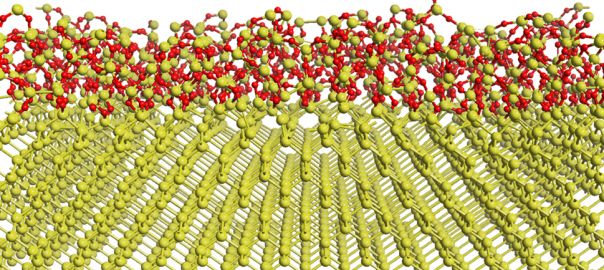Simulation Group
As the scaling down of semiconductor devices proceeds, next-generation devices which applied new structures, new materials, or new principles are researched actively. In order to perform the efficient research and development of next-generation devices, it is necessary to analyze at the atomic level by utilizing simulation techniques. In our group, we use calculation techniques such as Molecular Dynamics (MD) methods and Monte-Carlo (MC) methods. We are working on researches to reveal the dynamic behavior of atoms and carriers in a semiconductor from atomistic perspective.
We have been conducting simulations on the behavior of the phonon and carrier in semiconductor devices, application oriented material designing, and performance prediction of nano-scale transistors.
The current research themes are as follows:
- Study on the high-k/SiO2 interface characteristics for high-performance of solar cells
- Development of interatomic potentials for Si,O, C mixed system for power devices
- Analysis of the behavior of the phonon and heat in nano-sized semiconductor crystals
- Performance prediction of ultrafine MOSEET by EMC-MD simulation
Nano-device Group
Si-CMOS technology is undergoing a big evolution to adopt 3D-device structures to overcome the short-channel effect. The current flow from source to drain can be effectively controlled by surrounding the channel with the gate electrode.
Utilizing the cleanrooms and nanofabrication facilities in Waseda University, we are handmaking Si nanowire FETs, which is considered as one of the promising candidates for high performance devices due to their immunity for short-channel effect. Computer simulation is also used to predict and analyze the electric characteristic of the nanowire FETs.
STM Group
Aggressive scaling down of Si-CMOS devices suffers from problems such as short channel effect and an increase in the series resistance. An effective solution is to replace the conventional doped source and drain with a metal silicide. We are conducting atomic scale observation of the interaction between metal and silicon substrate aiming at the precise control of the silicidation reaction.
We performed atomic scale observation of the interaction between vacancy defects on Si(111) surface and Ni atoms irradiated onto the surface. It is suggested that implanted Ni atoms strongly interact with vacancy defects in the Si substrate. We expect that the growth of Ni silicide can be controlled by the crystal defect introduced intentionally.
UAV Group
Small unmanned air vehicle (UAV) is attracting lots of attention for its potential applications in the real-time monitoring of inaccessible hazardous areas and monitoring of infrastructures. Especially, flapping type UAVs are expected as ultimate ones because of the possibility to reproduce the sophisticated flight performances of actual flying animals, such as hovering, looping, and steep turning.
We have been developing a flapping robot inspired from dragonfly. Each wing of the dragonfly is driven by multiple independent muscles, thereby it enables not only the simple flapping motion but also the feathering in an active manner. To realize the function of the muscle system of the dragonfly, we developed an original actuator “scissors swing motor”. It is driven by a couple of voice coil motors (VCMs) witch are used in the hard disk drives. The flapping amplitude, frequency, and angle of attack can be controlled actively unlike the most of conventional flapping robots utilizing crank mechanisms.
Topics we are researching toward autonomous flight:
- Sophisticated control flapping motion
- Downsizing and lightening of the flapping robot
- Impact of the wing shape and flapping manner on the lift
- Robot vision
